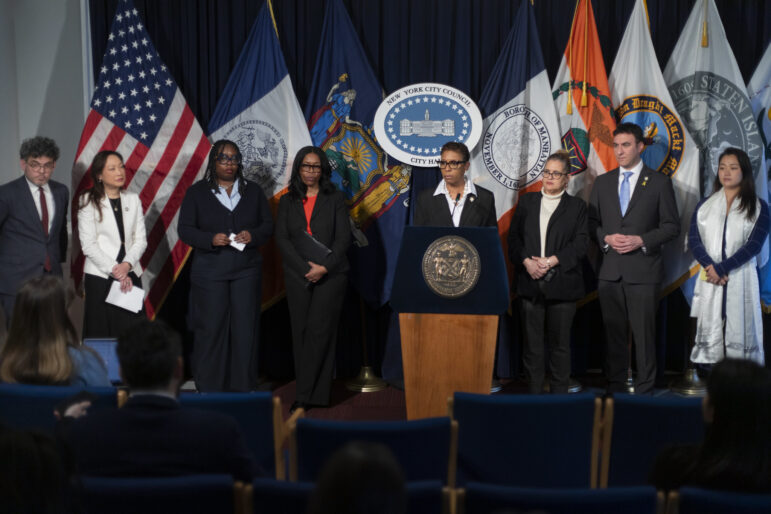When the New York State Commission on Sentencing Reform issued its final report last week, most attention centered on its recommendation to reform the so-called Rockefeller drug laws. But the commission also proposed the virtual elimination of parole – a move with practical implications for thousands of prisoners and historical significance for the state.
New York state prisoners are sentenced under two different regimes. Some are sent behind bars for a “determinate length of time” – say, five years. Others are given an “indeterminate” sentence, like five to 15 years. Once a person serving an indeterminate sentence has served the minimum amount of time, he or she can apply to the Parole Board for release.
The state’s two-track system reflects more than a century of shifting views on the purpose of incarceration. Parole, the first use of which is traced to the Elmira Penitentiary in 1877, grew out of a belief that prison was meant to rehabilitate, and not merely punish, inmates. Since each prisoner was different, the theory went, and one could not predict how much time behind bars would be necessary to rehabilitate each inmate, a board was given discretion over when an inmate could be set free. This corrections philosophy was dominant into the 1960s.
By the late 1960s and 1970s, however, the tide had turned. Rising crime on the streets prompted law-and-order conservatives to demand a tougher line on criminals. Prison riots brought liberals’ attention to the disparities and resentment created by discretionary parole. A series of executive and legislative panels looked for ways to reduce or eliminate the use of parole in New York state, but with little success – until George Pataki became governor in 1995. In a series of laws over his three terms, Pataki and the legislature eliminated parole for different classes of criminals: first violent felons, then drug offenders and finally sex offenders.
Now the only people eligible to be sentenced to prison terms that carry the possibility of parole are those convicted of non-violent, non-drug, non-sex crimes such as grand larceny. Those 3,500 inmates comprised one-fifth of new court commitments to state prisons in 2007 (the most recent year for which statistics have been published).
Now the sentencing commission wants to end parole for those inmates, too, arguing that determinate sentencing “promotes greater uniformity, fairness and ‘truth in sentencing’ … [and] allows for more informed plea bargaining, with both the parties and the court having a clearer picture of the actual time the defendant is likely to spend under custody.” The commission’s report adds that “determinate sentencing has been the unmistakable trend in New York.” Next the state legislature will decide whether and how to translate the commission’s recommendations into law.
The parole trend in New York mirrors national trends: According to a 2002 report from the Urban Institute, the share of prison releases determined by parole boards nationwide dropped from 65 percent in 1976 to 24 percent in 1999.
Getting rid of parole means figuring out how to set sentences for the crimes for which parole in now available. The commission recommended basing new sentences on a statistical analysis of the current system, looking at how much time prisoners who do not get parole typically serve. For example, currently, a first-time B felony conviction, as for assault in the first degree, could bring a minimum sentence of 1 to 3 years or a maximum of 8 1/3 to 25 years. In reality, those prisoners usually serve one to eight years if they get parole. If they don’t get parole, they typically serve two to 17 years. Under the commission’s proposal, they could be sentenced to a minimum of one year, up to a maximum of 16 years.
Two commissioners voted against eliminating parole for those offenders, but the commission wouldn’t say who they were. When the commission issued its draft report in October 2007, one opponent of the move to end indeterminate sentencing was then-Parole Board chairman George Alexander. His argument was that ending parole removed an incentive for inmates to address their substance abuse problems, go to school or learn a trade while inside. “Simply put, if an inmate’s programming bears little or no relation to his or her release, what motivation is there to have them participate in programs?” Alexander wrote. In the absence of parole, inmates could still chip time off their sentences by behaving well and participating in some programs, but the system would lose its flexibility to address individual achievements and circumstances.
Alexander resigned from the Parole Board in December after the state inspector general alleged he had stolen a state-owned laptop, and now faces felony charges in that case. The person tapped to replace Alexander at the Parole Board, Felix Rosa, stepped down last week citing personal reasons. The Division of Parole didn’t comment for this article. Under the commission’s proposal, the division would be still be responsible for monitoring inmates whose sentences require a period of post-prison supervision.
That supervision period is the focus of greater research and policy formation now than in years past, according to Michael Jacobson, director of the Vera Institute of Justice, which is involved in a multi-year project for the parole division. Nationwide when parole is used, Jacobson said, many parolees end up going back to prison for violating the terms of their parole, which is expensive. In a parole-less context, however, when offenders leave prison and enter supervision, more services are becoming available to provide life skills and avoid recidivism, thus providing “more public safety at less cost,” he said.
In 2007, the most recent year for which the state Department of Correctional Services has published statistics, 45 percent of those released from state prisons, or roughly 13,000 people, got out on parole. People who were already sentenced prior to the changes under Pataki can still get parole, even if they are violent, drug or sex offenders.
People convicted of A-1 felonies like murder, who are sentenced to long terms like 25 years to life, can still get parole even under the Pataki-era laws – although it’s a matter for debate whether those inmates obtain parole far too often or not often enough. Last year, Republican legislators complained of an “alarming increase in the parole release rates for A-1 violent felons that has occurred since Governor Eliot Spitzer took office.” But a class action lawsuit in federal court argues the opposite – that under Pataki, A-1 felons were illegally and unfairly denied parole, and that it hasn’t gotten much better under Spitzer or currently under Gov. David Paterson. The judge in the case is considering a motion to force Pataki to provide a disposition in the case.
The sentencing commission’s recommendations on parole garnered little attention last week. Advocates for the imprisoned focused on the commission’s suggestions to reform the Rockefeller drug laws and weren’t inclined to shift attention to other aspects of the report. Prosecutors welcomed the move to determinate sentencing, although with little fanfare; it has been the trend in New York for more than a decade. “We agree with the Commission on determinant sentencing and believe it to be workable except for Class A felonies,” said Bronx District Attorney Robert Johnson in a statement.








